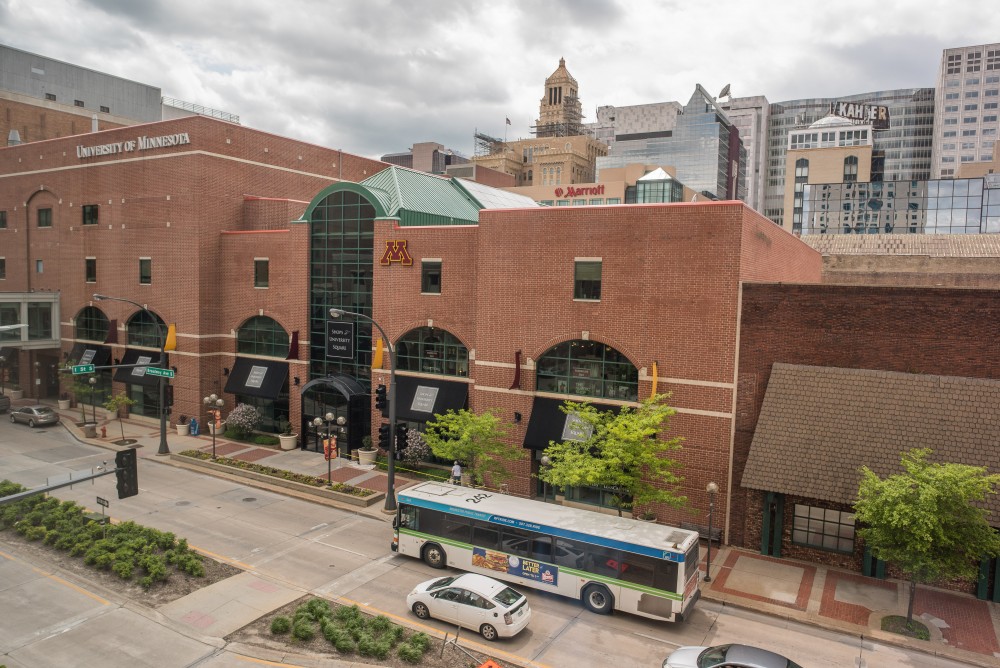The Rochester campus is the newest of the University of Minnesota’s five-campus system. But after a decade into an innovative approach to higher education, campus leaders are looking to the future with “bold” plans for growth.
The campus, which admitted its first class of 57 students in 2009, aims to expand not only enrollment, but its influence on post-secondary instruction.
Rochester Chancellor Lori Carrell recently presented the school’s long-term planning efforts to the Board of Regents — a vision she describes as the “Bluff Top” view project. Evoking the region’s distinct bluffs, Carrell said planning for the Rochester campus meant “climbing up and looking out into the distance to see as far as we could. What this campus would look like in the future in its very best version: Its most beautiful and breathtaking view.”
The ambitious plan moves from “bold” to “bolder” to “boldest,” Carrell said. That starts by adding around 200 more students on campus — moving from just over 500 undergraduates to 700 undergraduates by 2021, in addition to a slight increase in the school’s partnership graduate programs. From there, the campus is looking to enroll more than 1,000 students in the coming decade, then 1,500 students and eventually sustain around 2,500 students in total, Carrell said.
With growing demand for health care professionals, University of Minnesota-Rochester leaders are confident the expansion will pay off. Although it’s a drop in the bucket of the entire University system, the plan is a large jump in growth for the University’s smallest campus.
The school is planning to increase recruitment efforts and four-year scholarships to attract more students. Though it faces some challenges when it comes to space, Carrell said the school can continue to expand the number of students without sacrificing the quality of its education.
Growing demand, growing enrollment
Established in 2006, the University of Minnesota-Rochester has a unique approach to health-sciences education, with a focus on interdisciplinary learning. Students work in cohorts, courses have flipped instruction and active classrooms and all undergraduates are required to do research. Tenure-track faculty provide health sciences instruction, but their primary research is on education innovation, Carrell said.
“One thing about Rochester is that they’re a different type of campus,” said Lincoln Kallsen, assistant vice president for institutional analysis, who has worked with Carrell on the campus’s plan. “It’s just a very different model for instruction and student support. And apparently [it’s] having some success overall.”
Instead of offering a wide array of majors and minors, the campus provides a limited number of degrees — including Bachelor of Science degrees in Health Sciences and Health Professions — that serve as “career pathways” to a variety of health care professions or advanced degrees.
As evidence of success, Carrell pointed to the absence of an achievement gap at UMR, even with the campus’ diverse student body, which consists of more than 60 percent from underrepresented communities.
“Such a startup public University is rather unusual,” she said. “Our way of doing education is different on purpose.”
However, the school is still looking to show others that their approach to education can work.
“They sort of have grown from nothing,” Kallsen said. “They are trying a completely different model and trying to see if they can get it to scale.”
Carrell said the school’s plans for expansion match the increasing demand for health care professions. She highlighted data by the Minnesota Department of Employment and Economic Development, which shows that nearly 30 health care occupations requiring an undergraduate degree are growing by 10 percent more. That translates to more than 92,000 new jobs in the coming decade.
“We know there’s an incredible workforce demand just in our own region,” she said. “There are grand challenges in higher education … we have this unique privilege at UMR to pilot and test solutions.”
Several regents expressed optimism for the campus’s plans at a meeting last month.
“I think it’s a very unique program. I like the interaction between the faculty and students. It’s very special,” said Regent Randy Simonson at the meeting. “This really looks good to me.”
Regent Darrin Rosha echoed that support. “When you think about the University’s unique position, what Rochester is doing and the high level at which it’s doing it, it really exemplifies I think how we differentiate the flagship system and the state,” Rosha said.
However, the expansion doesn’t come without challenges, including the need for additional housing, faculty offices and academic space in the coming years.
Unlike other campuses, the University doesn’t own any space on the Rochester campus, instead leasing its buildings. “That gives the University of Minnesota-Rochester greater flexibility, but it also gives them additional challenges to manage,” Kallsen said.
Several of the University’s leases are expiring in the coming years, Kallsen said, including the building that houses faculty offices, which means the University will have to find new space. The campus is also looking to add affordable housing for undergraduates in a hot housing market, he said.
But Kallsen said the plans for growth will be made possible from new student tuition.
“We’re pretty confident we can do this without adding significant state resources,” he said. “Most of the revenue growth is going to be just from adding new students.”
Carrell said the campus is optimistic about bringing in more students and putting out more graduates, who not only benefit the state’s workforce, but also provide evidence that UMR’s instruction model is working.
“We have much yet to learn about how to do what we do even better,” she said. “And UMR gets to contribute to that.”








